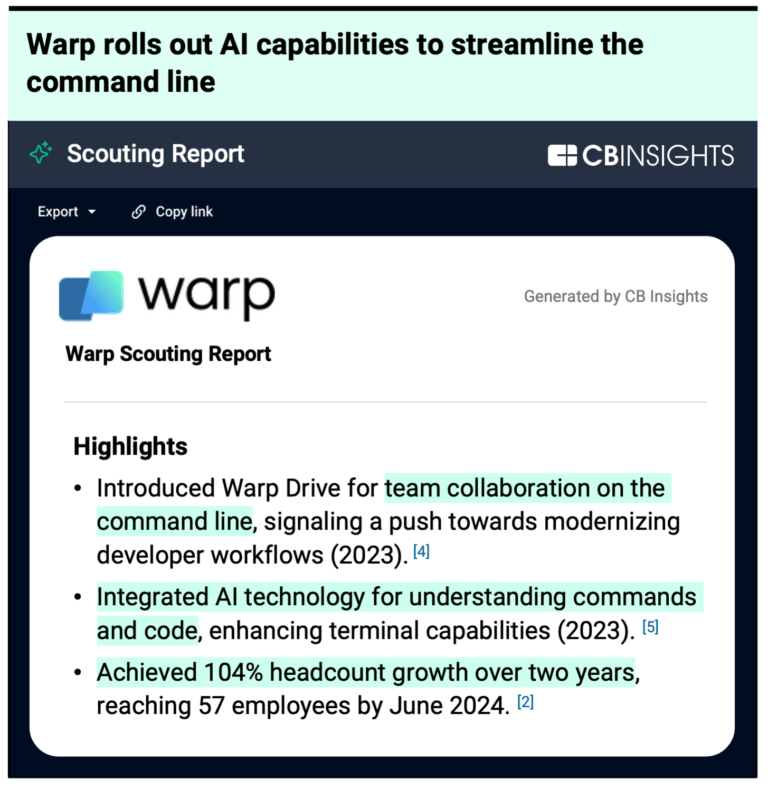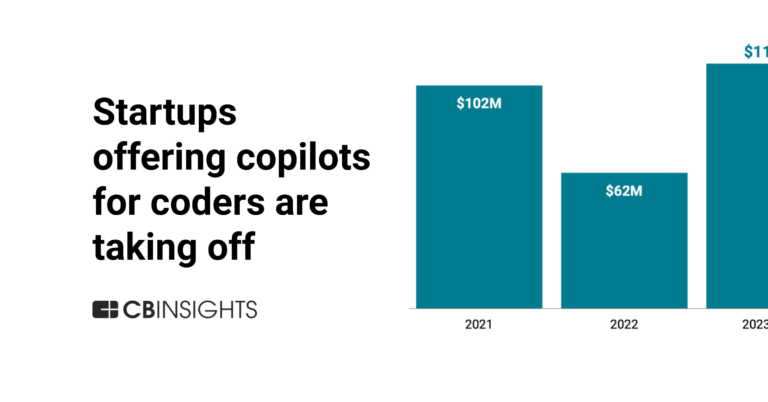
Warp
Founded Year
2020Stage
Series B | AliveTotal Raised
$73MLast Raised
$50M | 2 yrs agoMosaic Score The Mosaic Score is an algorithm that measures the overall financial health and market potential of private companies.
-61 points in the past 30 days
About Warp
Warp focuses on modernizing the command-line interface for developers by offering a Rust-based, GPU-accelerated terminal. The company provides a terminal experience that features a sequence of command blocks, an integrated text editor with intellisense-like autocomplete, and collaborative tools to enhance productivity. Warp's products are designed to make the command line more intuitive and collaborative, catering to the needs of modern developers and teams. It was founded in 2020 and is based in New York, New York.
Loading...
Loading...
Research containing Warp
Get data-driven expert analysis from the CB Insights Intelligence Unit.
CB Insights Intelligence Analysts have mentioned Warp in 6 CB Insights research briefs, most recently on Apr 7, 2025.
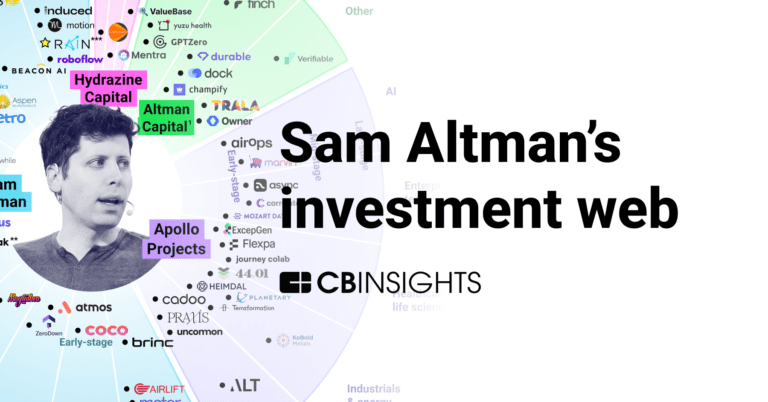

Mar 21, 2025 report
7 tech M&A predictions for 2025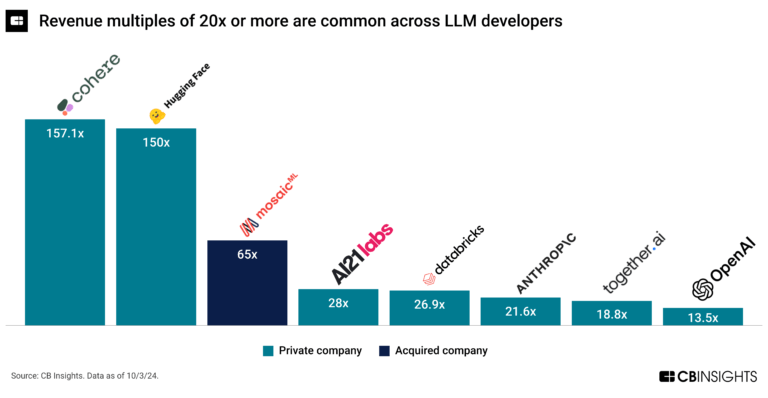
Oct 4, 2024
The 3 generative AI markets most ripe for exits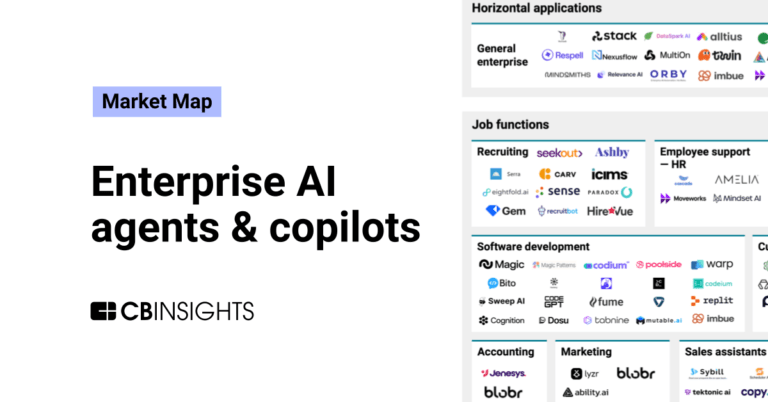
Aug 7, 2024
The enterprise AI agents & copilots market mapExpert Collections containing Warp
Expert Collections are analyst-curated lists that highlight the companies you need to know in the most important technology spaces.
Warp is included in 5 Expert Collections, including AI 100 (All Winners 2018-2025).
AI 100 (All Winners 2018-2025)
100 items
Generative AI 50
50 items
CB Insights' list of the 50 most promising private generative AI companies across the globe.
Generative AI
2,841 items
Companies working on generative AI applications and infrastructure.
Artificial Intelligence
10,402 items
AI Agents & Copilots Market Map (August 2024)
322 items
Corresponds to the Enterprise AI Agents & Copilots Market Map: https://app.cbinsights.com/research/enterprise-ai-agents-copilots-market-map/
Latest Warp News
Sep 10, 2025
Geeky Gadgets 9:45 am What if coding wasn’t just about writing lines of logic but about creating an experience tailored to your unique rhythm and style? Enter the era of “vibe coding,” a fantastic concept that reimagines how developers interact with their tools. With AI at its core, vibe coding promises to make programming not only faster and smarter but also more intuitive and deeply personal. Imagine an environment where your tools anticipate your needs, adapt to your quirks, and even enhance your creativity. It’s not just about productivity anymore, it’s about crafting a coding experience that feels almost alive. At the forefront of this revolution is Warp, an AI-powered terminal, and its visionary CEO, Zach Lloyd, who is redefining how we think about developer tools. In this feature by Tina Huang featuring Warp CEO Zach Lloyd, learn how AI is reshaping the future of coding through the lens of vibe coding and the innovations driving it forward. From personalized workflows that align with your coding habits to tools that predict your next move, the possibilities are as exciting as they are fantastic. We’ll also delve into Warp’s unique approach to integrating AI into development environments and how it’s setting the stage for a new era of software creation. Whether you’re a seasoned developer or just curious about the future of tech, this journey into vibe coding will challenge your assumptions and spark your imagination. After all, the future of coding isn’t just about efficiency, it’s about creating a deeper connection between humans and machines. AI and the Evolution of Developer Tools TL;DR Key Takeaways : AI is transforming software development by automating repetitive tasks, providing intelligent code suggestions, and allowing personalized workflows, making coding more efficient and innovative. AI-powered developer tools, such as Warp, enhance productivity by streamlining workflows, detecting errors in real-time, and generating code snippets or entire modules based on minimal input. Businesses are using AI to accelerate product development, reduce costs, and improve collaboration, allowing faster time-to-market and data-driven decision-making. The concept of “vibe coding” focuses on creating a personalized coding experience by adapting to individual developer styles, preferences, and workflows, enhancing creativity and productivity. Future advancements in AI, including natural language processing and predictive analytics, aim to make coding more intuitive, collaborative, and innovative, transforming the development ecosystem further. AI has become a cornerstone of modern developer tools, designed to streamline workflows, reduce inefficiencies, and enhance productivity. These tools are transforming coding environments by automating routine tasks, providing intelligent suggestions, and fostering seamless collaboration. For instance, tools like Warp, an AI-powered terminal, showcase how machine learning can optimize the development process and improve overall efficiency. Here are some key ways AI is enhancing developer tools: Code Suggestions: AI-powered platforms predict and recommend code snippets, significantly reducing the time spent on repetitive coding tasks. Error Detection: Machine learning algorithms identify bugs and errors in real-time, allowing developers to address issues promptly and minimize debugging efforts. Code Generation: AI can generate entire functions or modules based on minimal input, accelerating project timelines and allowing rapid prototyping. By automating these essential yet time-consuming tasks, developers can redirect their focus toward solving complex problems and driving innovation. Whether you are debugging intricate issues or brainstorming new features, AI tools empower you to work smarter and more effectively. Bringing AI Tools to Life Live demonstrations serve as a compelling way to showcase the practical applications of AI in software development. Observing these tools in action provides a clear understanding of their capabilities and how they can seamlessly integrate into your existing workflow. For example, a live demo of Warp might highlight its ability to execute commands faster, provide real-time feedback, and integrate effortlessly with your development environment. These demonstrations also emphasize the versatility of AI tools across various programming languages and frameworks. Whether you are working on a small personal project or contributing to a large-scale enterprise system, seeing AI tools in action can inspire confidence in their potential and encourage their adoption. By witnessing their practical benefits firsthand, developers and organizations alike can better appreciate the value of incorporating AI into their workflows. The Future of Vibe Coding : Warp CEO Zach Lloyd AI in Business-Building and the Development Ecosystem AI is not only transforming individual productivity but also transforming the broader development ecosystem. Businesses, ranging from startups to multinational enterprises, are using AI to accelerate product development, reduce operational costs, and maintain a competitive edge. By automating mundane tasks and allowing rapid prototyping, AI tools empower companies to bring products to market faster and with greater precision. Here are some ways AI is reshaping businesses and the development ecosystem: Faster Time-to-Market: Automation and predictive analytics streamline development cycles, allowing quicker product launches and reducing delays. Enhanced Collaboration: AI-powered tools assist team communication, provide shared insights, and improve overall efficiency across distributed teams. Data-Driven Decisions: AI analyzes team performance and project data, identifying bottlenecks and suggesting actionable improvements to optimize workflows. By fostering collaboration, agility, and innovation, AI ensures that businesses remain competitive in an ever-evolving market. Organizations that embrace AI-driven tools position themselves to adapt quickly to changing demands and seize new opportunities. The Future of Vibe Coding and AI-Assisted Development The concept of “vibe coding” represents a new shift in AI-assisted development. This approach emphasizes creating a personalized and intuitive coding experience by analyzing an individual developer’s unique coding style, preferences, and workflows. AI tools are evolving to adapt to these nuances, making coding not only more efficient but also more enjoyable. Future advancements in AI are expected to take this concept even further. Here’s what the future holds for AI-assisted development: Natural Language Processing: AI tools will become more adept at understanding human language, allowing developers to communicate with machines in a more intuitive and conversational manner. Predictive Analytics: Advanced algorithms will anticipate developer needs, offering solutions and suggestions before problems arise, further streamlining workflows. Enhanced Creativity: AI will assist in brainstorming and problem-solving, fostering innovation and allowing developers to explore new ideas with greater confidence. By handling technical details and repetitive tasks, AI allows developers to focus on the bigger picture, unlocking new levels of creativity and productivity. This shift not only enhances individual performance but also drives innovation across the entire software development industry. Audience Engagement and the Path Forward Engaging with your audience is essential for driving awareness and adoption of AI-powered tools. Interactive discussions, live Q&A sessions, and hands-on demonstrations can help demystify AI technologies and showcase their practical benefits to both technical and non-technical stakeholders. Addressing common questions and concerns builds trust and highlights the tangible value these tools bring to the development process. As the integration of AI into coding practices continues to evolve, it will open up new opportunities for innovation, collaboration, and growth. Whether you are an experienced developer or just beginning your journey, embracing AI tools can help you stay competitive in an increasingly dynamic and fast-paced industry. By adopting these technologies, you position yourself at the forefront of a rapidly changing field, ready to tackle the challenges and opportunities of tomorrow.
Warp Frequently Asked Questions (FAQ)
When was Warp founded?
Warp was founded in 2020.
Where is Warp's headquarters?
Warp's headquarters is located at 11 Prince Street, New York.
What is Warp's latest funding round?
Warp's latest funding round is Series B.
How much did Warp raise?
Warp raised a total of $73M.
Who are the investors of Warp?
Investors of Warp include Google Ventures, Marc Benioff, BoxGroup, Neo, Jeff Weiner and 10 more.
Who are Warp's competitors?
Competitors of Warp include Fig.
Loading...
Compare Warp to Competitors
Fig offers a software development tool for clients. It allows clients to build visual applications to streamline terminal workflows. It was founded in 2020 and is based in San Francisco, California. In August 2023, Fig was acquired by Amazon Web Services.
Loading...

